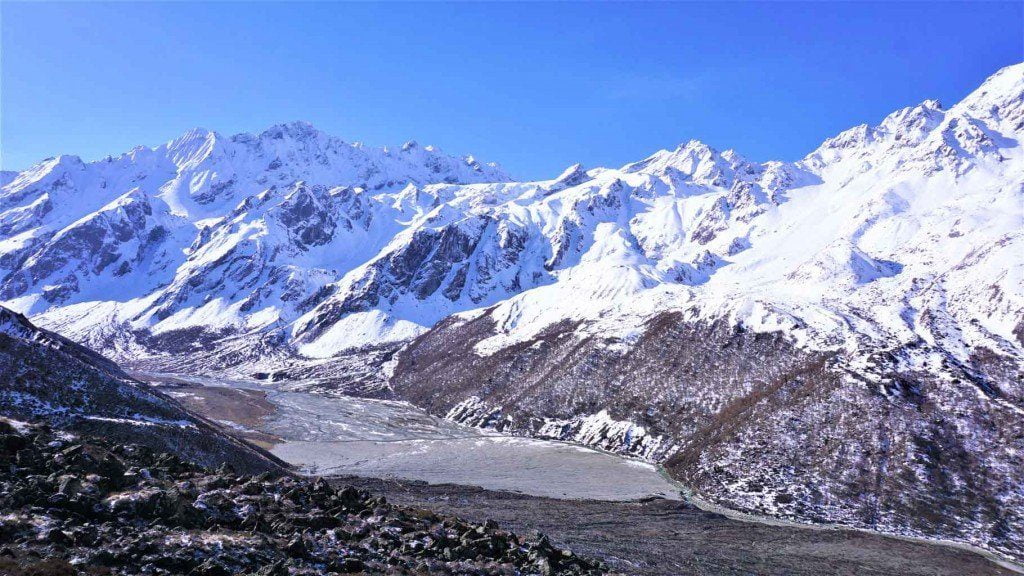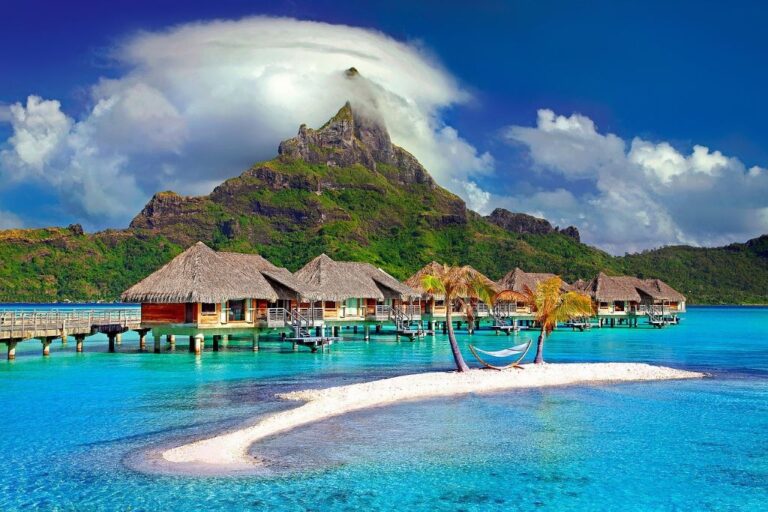Best time for Langtang Valley Trek, weather, and Temperature
The Langtang Trek in Nepal is an amazing experience that lets you explore verdant landscapes and quaint villages. The Langtang region of Nepal is surrounded by breathtakingly beautiful scenery. The Tamang tribe has a distinct and substantial cultural presence in the Langtang region, which is a sort of Tamang community. You will have the opportunity to take in the scenery of Langtang Lirung, the tallest peak in the area, as you make your way through the Langtang region. Compared to nearly all treks in Nepal, this Langtang climb is not a true lengthy one. It’s also among Nepal’s shortest treks. For those who are willing to spend their limited time enjoying the Himalayas, it might be a good option.
After leaving Syabrubesi, a small town near the Bhote Koshi River, the Langtang Trek continues through woods of bamboo and rhododendron. Hiking along the track causes Mother Nature to transform, revealing stunning valleys and mountains all around you. The pinnacles you will traverse are visible from Kyanjin Gompa, the magnificent settlement with a monastery where you will reach the finish line. Ensure that you are accompanied by a Langtang Trek guide. The ideal time to hike Langtang and the weather in Langtang Valley will be discussed in this article.
Best season for Langtang Valley Treks
Trekking in the Langtang Valley in the spring and autumn is an amazing experience that offers a new facet of the environment with every step you take. In the valley, the spring season lasts from March until May. From now on, it will be accompanied by a variety of flowers, not just wildflowers and rhododendrons. As a result, it is suitable for activities outside the home because it is neither extremely hot nor chilly. The vista that greets visitors most often is a clear blue sky covered in Langtang Lirung, the highest point, and other mountains.
September through November is another excellent season for a Langtang hike in the fall. Hiking is possible since the weather in the Langtang Valley is consistent, with clear sky and decent visibility. The regions that provide a perfect view of the mountain ranges encircled by clear skies border the valleys. In addition, the path will be cleaner and drier than during the monsoon, which will lessen the likelihood of hikers slipping. There are many opportunities for a photographer to get the ideal snap of Nepal’s breathtaking Langtang Valley because of the vibrant colors and blue sky.
Langtang treks in Spring
During the spring walking season, which runs from late March to the end of May in the Langtang, visitors may take in the breathtaking scenery of vivid vegetation, towering mountains, and a wonderful climate that suits all year round. Springtime in Langtang is enlightenment to the world: it’s as if mother nature is bringing back life that has faded and bringing in new life that is bright and colorful. The most magnificent rhododendron blossoms, in shades of red and pink, give the hill a distinctive look. The greatest time to go on a Langtang walk is in the spring, when we can also see the valley’s fauna and learn about the rich cultural diversity of the region.
Langtang Trek March Weather
In March, the temperature in the Langtang Valley Trekking above average, with daytime highs of 10 to 15 degrees Celsius (50 to 59 degrees Fahrenheit). The higher areas can become colder. The snow-browned walkways are starting to sprout again. The first blooms of these exquisite wildflowers, such as the rhododendron, will appear in the spring. An peculiar music is added by the roaring, whirling rivers and streams as well as the frozen snow waterfalls adorned with sparks.
Langtang Trek April Weather
In addition, April temperatures in the steep valleys of the Langtang Trek in Nepal range from 15-20 degrees Celsius (59-68 degrees Fahrenheit) during the day in the top regions of Langtang. The last family of plants found in highland woods, rhododendrons, are cultivated to reach their peak flowering and full bloom in vivid colors. For a visitor, this makes hiking an amazing experience. The snow from higher regions that melted recently is what keeps the rivers and streams moving at their ancient speed. The beautiful sky will be perfect for photographers who seek close-up shots of the nearby mountains because of its viewing potential.
Langtang Trek May Weather
The lower part of the Langtang Hike Nepal will experience May, the warmest month of the year, with typical daytime temperatures in the Langtang Valley Nepal ranging from 20 to 25 degrees Celsius (68 to 77 degrees Fahrenheit). Those are lively routes with views that will stick in your memory. The entire Langtang Valley is adorned with stunning floral trees, orchids, magnolias, and rhododendrons as the weather permits. The stream provides a tranquil experience for anyone strolling by, and the river seems to go on forever. Unquestionably clear vision on this particular day makes for an amazing walking experience with the ideal view of the winter peaks.
Pros of Langtang Treks in Spring:
Savor the various herbs and gorgeous orchard blossoms in this natural setting.
Enjoy the breathtaking views of flower-filled plains, waterfalls, and mountaintops covered in a shimmering layer of snow.
Walking in a t-shirt under clear skies above that allow for comfortable trekking, you will be greeted by the sun, whose rays thrill both the body and the soul.
Trekkers can witness a variety of grasses and animals in addition to the breathtaking natural splendor of the valley.
Cons of Langtang Treks in Spring:
The region’s high levels of tourism can be attributed to physically packed trails and a dearth of lodging choices.
However, preparations for walking are likely to be hampered by sporadic rains or unexpected, abrupt changes in the weather. Despite this, trekking is nevertheless generally pleasurable in favorable conditions.
One of the most important precautions against accidents caused by altitude is acclimatization, especially while walking at an altitude that is higher.
Langtang Treks in Autumn:
Autumnal color variations along Nepal’s Langtang Trail produce a visually arresting image as the vegetation turns crimson and yellow. The pleasant, mild weather in the Langtang Valley makes it possible to see the snow-capped peaks clearly, which makes it an excellent time for hiking and shooting photos. Fall is when the Langtang Valley in Nepal reveals its breathtaking beauty and calming atmosphere, which look so enticing.
Langtang Trek September Weather
September is a cool month in Langtang, with lows of 20 to 25 degrees Celsius in the lower regions of the Langtang Valley. This is when summer is almost over. Hiking is a great opportunity while there’s still some green left on the roads after the rain. Rivers and streams flow nonstop past the monsoon runoff point during the rainy season. Although September marks the end of the monsoon season in Langtang, there are sometimes occasional sprinkles of rain, the weather in Langtang is generally excellent for trekking.
Langtang Trek October Weather
October is considered to be one of the best hiking months in the Langtang region. October brings sunny, unobstructed skies and pleasant weather to Nepal’s Trekking to Langtang Valley. The lower regions get milder daytime temperatures, which range from 10 to 15 degrees Celsius (50 to 59 degrees Fahrenheit). The fall foliage, with its vibrant hues of red, orange, and yellow in the landscape paintings, is the most picturesque time of year to trek the Langtang. The streams continue to flow; they do not dry up. Photography is always enhanced by the amazing clarity of the sky, which displays the stunning vistas of the neighboring mountains.
Langtang Trek November Weather
The Langtang Valley in Nepal has a decrease in temperature in November, with an average daily temperature of 5 to 10 degrees Celsius (41 to 50 degrees Fahrenheit) in the lower elevations. The vivid color contrast contrasts with the snow-capped summits of the Himalayas as the Langtang Valley weather settles in. Yes, the streams and rivers continue to run. November is a great month to visit Langtang and explore the stunning Langtang Valley in Nepal since the sky clear up and the surrounding hills are perfectly visible.
Pros of Langtang Treks in Autumn:
Take in breathtaking views of the vibrant fall foliage set against the snow-capped mountains.
Enjoy pleasant trekking weather with clear skies and temperate temps.
Autumn trekking is less crowded than spring hiking, making for a more tranquil trekking experience.
Excellent visibility of the neighboring Himalayan peaks is provided by the clear autumn skies.
Cons of Langtang Treks in Autumn:
The onset of autumn brings with it a risk of sharp drops in temperature, particularly in higher altitudes, therefore proper attire and equipment are needed.
Autumn days grow shorter as winter approaches, which reduces the amount of time available for hiking and exploring.
Particularly in the lower parts, the dry fall weather can cause dusty trails that impair sight and air quality.
Langtang Treks in Winter:
The Langtang receives a lot of snowfall during the winter, which creates a bed of snow and an atmosphere that is serene, crisp, and lovely. Even in these bitterly cold temperatures, you may still walk along the Langtang Village trail and witness strange vistas of frozen biomes dotted with giant icicles and shimmering snow. The Langtang Trek package will provide you the chance to visit Langtang in the winter and witness some of the region’s most quaint and serene wildlife.
Langtang Trek December Weather
It’s winter and it’s snowing on December 1. Near the end of the valley, the temperature in Nepal’s Langtang Valley ranges from 0 to 5 degrees Celsius (32 to 41 degrees Fahrenheit). Snow covers the whole Langtang trail in Nepal, giving the impression that it is winter there in December. In certain areas, they might be covered in ice, which would seem to add to the area’s attractive qualities. The days are lovely, with bright skies and breathtaking scenery, but the nights can get very cold, so you’ll need to pack warm clothing and carry adequate insulation for your trekking excursion.
Langtang Trek January Weather
The coldest month to travel in the Langtang Valley is January in Langtang. Conditions are typically brighter and warmer, with lower places reaching 0°C (32°F). The Langtang Trek in Nepal becomes an idyllic, tranquil place as the valley appears to be blanketed in a thick layer of snow. Along the trekking trail, snow substitutes characteristic ice structures like icicles and spikes for flowing water. However, January in Langatng is renowned for its breathtaking scenery, which includes frightful frozen rivers and breathtakingly gorgeous snow-capped mountains that become visible as the sun rises.
Langtang Trek February Weather
The walk across the Trek to Langtang Valley often reaches its peak in February, when the daytime temperatures gradually get kinder. The lowest temperatures are found at higher elevations, even if nighttime lows may infrequently go below freezing. Although the Langtang Valley in Nepal is covered in snow, the occasional sunny day lifts the spirits and makes the hike up the valley even more enjoyable. February is a unique winter month in Langtang, with spring flow guaranteed for the most accomplished hikers.
Pros of Langtang Treks in Winter:
Discover the enchanted splendor of the snow-capped Langtang Valley journey, which produces breathtaking scenery.
Because fewer people hike in the winter, trekking can be more tranquil and pleasant.
The clear winter air makes it possible to see the neighboring mountains clearly, giving breathtaking sweeping views.
Winter trekking is a unique experience since you can see icicles, frozen waterfalls, and other winter wonders all along the trail.
Cons of Langtang Treks in Winter:
Wintertime can be bitterly cold, especially in higher altitudes, therefore insulation and appropriate cold-weather clothing are necessities.
There may be fewer possibilities for staying during the winter months due to the closure of some tea houses and motels along the trekking path.
Trekking in the Langtang Valley of Nepal requires caution and alertness due to the possibility of avalanches and snowfall in specific regions caused by winter weather.
Wintertime brings fewer daylight hours, which could limit your hiking time. Getting an early start and careful planning may be necessary to make the most of the daylight.
Langtang Treks in Summer:
Langtang, Nepal, thrives in the summertime amid lush vegetation replete with blooming flowers and lively plants. The valley’s diverse flora and fauna can be explored throughout the generally pleasant and warm days. Trekkers should prepare for erratic weather in the Langtang Valley throughout the summer months, since the region has regular rainfall and occasionally monsoon rains during this time.
Langtang Trek June Weather
The seasonal monsoons in Langtang, Nepal, which last from June to July, are marked by constant high humidity and precipitation. Depending on the altitude, daytime temperatures in the Langtang Valley can range from 20 to 25 degrees Celsius (68 to 77 degrees Fahrenheit). The meadow is heavily forested, with plants growing well in the right circumstances. The monsoon season’s rains has caused the rivers and streams to swell, resulting in rushing white waters. June gives a unique trekking experience here despite the rain because the valley is full of roaring water, blue primrose, and numerous orchids.
Langtang Trek July Weather
The major monsoon season in Langtang, Nepal, occurs in July. This brings with it heavy rains and humid temperatures in the Langtang Valley. The Langtang Valley’s daytime temperature ranges from 20 to 25 degrees Celsius (68 to 77 degrees Fahrenheit) in the low areas. The clouds and mist continue to cover the valley. The trip is made much more amazing and memorable by the joyful fall of rivers and streams. July is a difficult month to hike in Langtang because of the heavy rain, which turns the area verdant and covered in daisy-like blossoms.
Langtang Trek August Weather
August marks the conclusion of Langtang Valley’s monsoonal season. Rainfall eventually starts to lessen. In lower altitudes, the daytime temperature range is 20°C to 25°C. The rainy season has ended, leaving the valley lush and verdant with an abundance of vegetation. The trekking route receives much-needed scenic appeal from the smoothly flowing rivers and streams. However, because of sporadic rainfall, walking in Langtang in August can be difficult. Nevertheless, the valley is breathtaking, with vibrant hues of marigolds, asters, and sunflowers.
Pros of Langtang Treks in Summer:
Take in colorful scenery that is replete with blossoming flowers and rich flora.
See a variety of flowers along the way, including orchids, primroses, and wild roses.
In the monsoon season, less people venture out, so you may enjoy quieter trekking pathways.
Experience the customs and festivals of the area as they are observed in the trekking communities.
Cons of Langtang Treks in Summer:
Deal with challenges including persistent rain, slick paths, and possible landslides.
Mist and cloud cover could block the expansive vistas of the mountains.
Insect repellent and protective gear are necessary while dealing with increasing mosquito activity.



